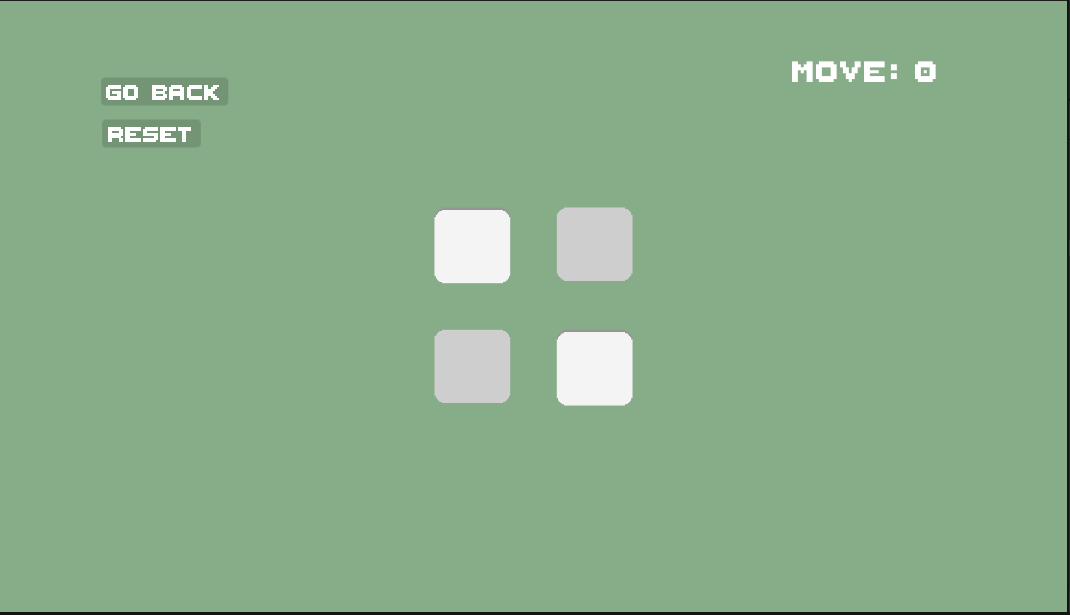Turn it Off
Type: Video Game
|
2024
Turn it Off is a simple puzzle game where the player’s goal is to turn off all of the buttons on the screen by pressing them (toggling them on/off). Each time a button is pressed, the surrounding buttons are also toggled, making the whole thing a game of reflection and trial and errors. As the level go, they get bigger, harder and introduce extra challenges for the player. Turn it off is still in development because I want to make more levels for it before officially launching it, but the core mechanics and gameplay loop is complete. If you would like to try the beta, you can find it here.
Game Description
The game is truly a simple experience in my opinion. While the puzzle itself will (hopefully) take some thinking, the mechanics are quite easy to grasp. For each level, the player is presented with a number of buttons arranged in different order, some turned on, some turned off. The player’s goal is to toggle the buttons until they are all off, while pressing a button toggles the one directly next to it to also toggle on/off. In order to play, a player only needs a mouse to press the buttons.
Be ready for some harder challenges as more level get unlocked and created. In later levels, some buttons are broken and won’t be turned on ever, but they also will block the progression by isolating certain buttons in their corners. Hopefully you will have fun thinking of the fastest ways to solve each puzzle and find new ways to solve them that I hadn’t thought of!
Gallery




Game Development
What originally started as a way of making my linear algebra homework easy and faster to solve (but probably took me longer to code than it would’ve to solve the problems) eventually transformed into an actual game after I showed the project to my friends and partner. I originally had planned on using the code to only find every possible solution to the problem given on the homework, so once I decided to make the project an actual game, it took me a little bit of refactoring to make the buttons more easily arrangeable. This allowed me to create more easily levels.
The hardest part was ironically not the programming of the game, the mechanics really only being pressing buttons on the screen, it was quite simple to create a prefab that could just be copied over and over again. The real difficult part was coming up with the puzzles and making them hard enough to be worth the game. Trying to come up with puzzles means I also had to solve them all myself first in order to make sure they were possible, which is actually what I think took the longest in the development. I think the first batch of 5 levels for the demo took me a week to design. But as I got more used to it, I started finding it easier to design levels that were hard enough to be worth while, while not being impossible.
Eventually, after I added enough levels to makes sure the game takes at least an hour or two before finishing it, I would like to add a level editor, so that players can create their own level, and share them with their friends or the public. I don’t know how difficult the level editor would be, but it feels like a nice and fun challenge, same thing with a gallery of community levels. But the current main goal is to finish enough levels to release a first complete version of the game.
Final Thoughts
I think this game was a fun experience. Since I started game development at 14, this was the first game I did alone, without following a guide. I had so much fun working on this game. Don’t get me wrong, I absolutely love working with my friends on our games during the game jams, but I found it so fun to be able to create a game from A to Z without the stress of the time limit. What I found the most fun what coming up with the levels, they aren’t hard to add to the game, but they require me to get better at the game in order to make sure my ideas can be solved. I am really proud of what I make, and I will for sure continue to update this game overtime and add levels every now and then once I release a full version of the game. Once again, if you would like to try the beta of the game, you can find a release on its Github repository.
© Copyright 2025. Made by Gab Savard.